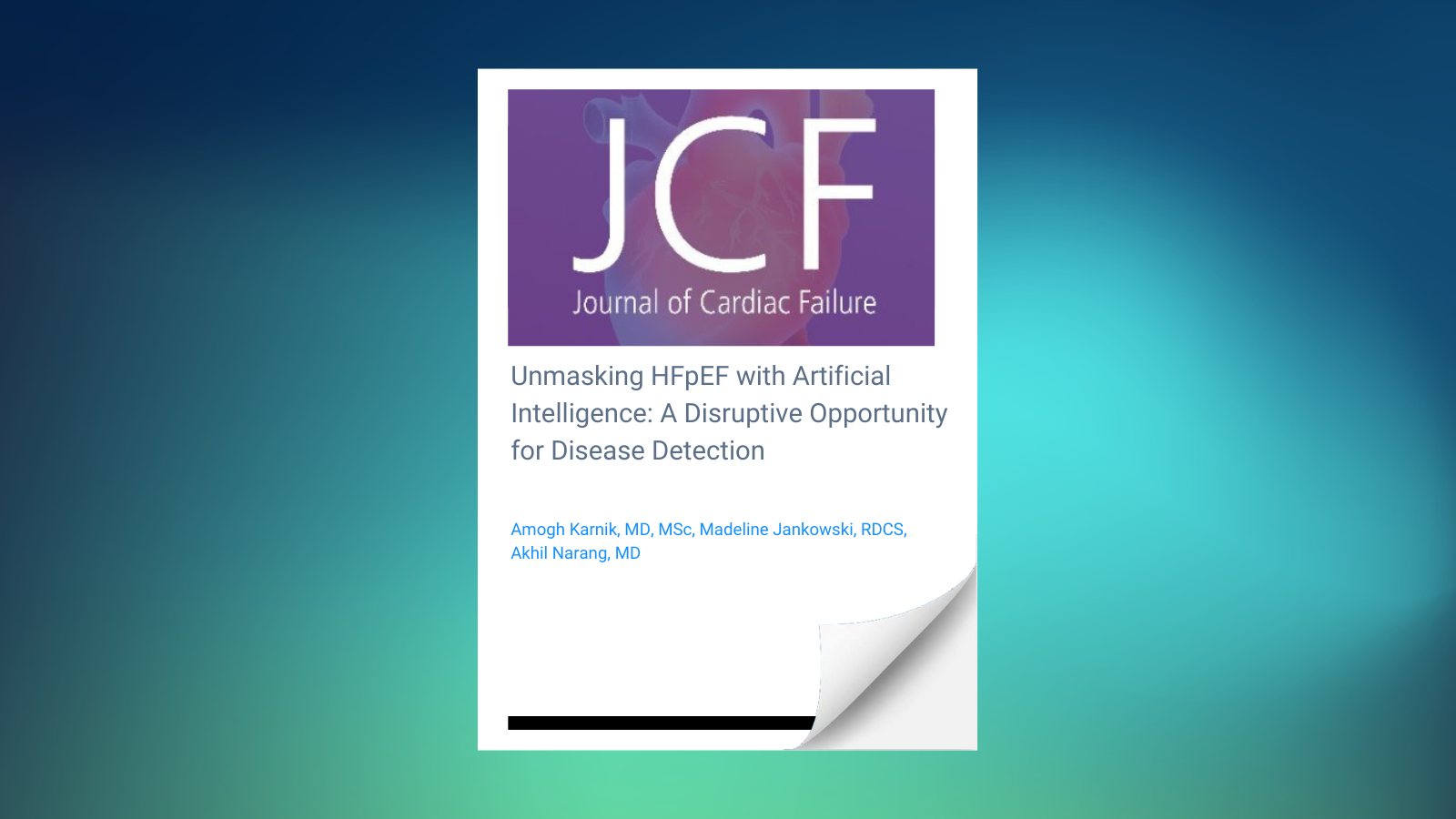
Unmasking HFpEF with Artificial Intelligence A Disruptive Opportunity for Disease Detection
- | By Ultromics
Amogh Karnik, MD, MSc, Madeline Jankowski, RDCS, Akhil Narang, MD
View the full publication here
Background
Heart failure with preserved ejection fraction (HFpEF) is a highly prevalent clinical syndrome that accounts for the majority of heart failure cases around the world. The prevalence of HFpEF has previously been reported to be between 1-5.5% of the general population [1]. However, this may be underestimated, given that diagnosis remains challenging, owing to a multitude of different etiologies and presentations that can be attributed to HFpEF [2]. With newly available therapies, making an earlier diagnosis of HFpEF has the potential to significantly change the trajectory of a patient’s disease course.
While clinical scoring systems such as HF2PEF have been validated as important diagnostic methods for HFpEF diagnosis, advances in artificial intelligence (AI) technologies have allowed for novel approaches to HFpEF diagnosis by way of automated analysis of echocardiograms. A novel, AI based analysis tool that uses a single, four chamber apical view from a transthoracic echocardiogram (TTE) to screen for HFpEF has been developed and cleared by the FDA (EchoGo Heart Failure, Ultromics Ltd). However, real world evaluation at scale has been limited.. The purpose of this study was to evaluate whether an AI system can detect HFpEF reliably compared to routine echocardiographic analysis.
Methods
We aimed to assess the performance of this software in a real-world setting to better estimate prevalence of HFpEF within our patient population. We retrospectively evaluated clinical echocardiograms performed and compared the AI anaylsis with clinical interpretations of echocardiograms. For all patients screened positive for HFpEF, we performed a manual chart review including calculating a HF2PEF score to ascertain clinical risk factors that corroborated the diagnosis.
Results
We performed a comprehensive analysis using the AI HFpEF algorithm on 692 consecutive clinical echocardiograms from unique patients. 71 studies were excluded for suboptimal TTE image quality while 89 were noted to have LVEF <50%. Of the remaining 532 studies with LVEF >50%, 117 (16.9% of 692) screened positive for HFpEF.
Of these 117 patients, 56 (47.9% of 117) had a documented HFpEF or HF with improved EF. Of the remaining patients, 33 (28.2% of 117) had documented structural heart disease (moderate or greater valve stenosis or regurgitation, valve repair/replacement, heart transplant) which are associated with HFpEF. Upon the remaining 28 patients, 17 had HF2PEF scores of at least 50% (moderate or higher probability of HFpEF) [4] and 11 had incomplete HF2PEF scores (due to lack of interpretable tricuspid regurgitation (TR) continuous wave Doppler signal, precluding estimate of PASP).
Discussion
The diagnosis of HFpEF is made clinically with supportive tools such as the HF2PEF score. This score requires knowledge of clinical and echocardiographic information and is not conventionally documented in an echocardiographic report. Similarly, the presence of diastolic dysfunction reported on an echocardiogram is not synonymous with HFpEF. Efforts to improve and simplify the recognition of HFpEF using echocardiography alone would likely lead to earlier intervention.
Our study demonstrates the real-world use of AI echocardiography analysis is able to detect HFpEF from the echocardiogram alone without additional clinical information. Under half the patients in our cohort who screened positive for HFpEF had a chart documented history of HFpEF. Furthermore for the 28 patients in whom a HFpEF score may have been calculated, 11 of them (39.3%) had no measurable TR Doppler rendering the HF2PEF score incomplete. These 28 patients represent 23.9% of the overall 117 patients who would have otherwise required either a HF2PEF score or integration of clinical information to diagnose HFpEF.
This AI HFpEF detection algorithm represents a step forward in being able to correctly identify patients at risk for adverse events. It can be readily integrated within existing echocardiography reporting systems and if used at scale, it would mark a paradigm shift in the way imaging is used to raise the suspicion or perhaps diagnose HFpEF. Further outcomes data is needed on how this may change downstream testing and disease management of HFpEF.
